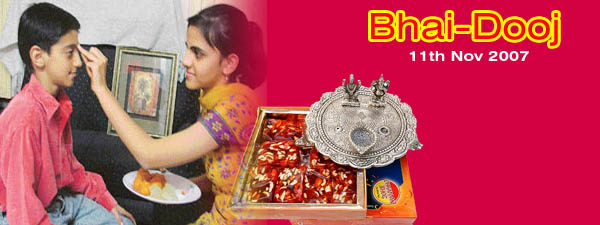Bhai-dooj

| Introduction |
| Home |
The second day of Shukla Paksh, the bright forthnight of Kartik is called Bhaiyaduj. There are various names of this festival. Known by the name of bhai-dooj in the Hindi-speaking belt, it is called "Bhav-Bij" in the Marathi-speaking communities and in Nepal, people know this festival by the name of "Bhai-Tika". In Uttar Pradesh, the brother is gifted with an `aabf- a length of flax, knotted into a circular shape and dotted with sugar batashas. There are two aabs for each brother. After performing all the rituals that include the sister applying a tilak of roli and rice on her brother's forehead and praying him with an aarti to shed off all the evil effects, the story of Bhai Dooj is narrated. In Punjab, the day following Diwali is known as tikka when sisters make a paste with saffron and rice and place an auspicious mark on their brother's foreheads as a symbolic gesture to ward off all harm. In Bengal this event is called 'Bhai Phota', which is performed by the sister who religiously fasts until she applies a 'phota' or mark with sandal wood paste on her brother's forehead, offers him sweets and gifts and prays for his long and healthy life. Diyas and incense sticks are an integral part of the ceremony. An aarti is also performed. In Bihar, sisters repeat the behavior of the central character of the story of Bhai Dooj, where a sister saves her brother life by cursing him until he gets married. The curse is seen as a mean to ward off all the dangers and evil effects of the spirits surrounding the brother. The sisters of Bihar start this day by showering choicest of curses on their brothers. After doing so, they prick their own tongues as punishment, with a thorny, wild fruit and ask for their brothers' forgiveness for the curses, and also for past mistakes. There is also a unique custom of brother eating grains of bajri with water, from their sisters' hands. A ritual involving brother and sister, Bhai Phota is observed by Bengalies that is almost similar to the north Indian Bhai Dhooj. However, sometimes due to specific timings according to Hindu calendar, Bhai Phota may be celebrated on the third day of the month of Kartik, instead of the second. On Bhai Phota sisters apply tilak to brother's foreheads with mantras for long and happy life |